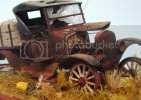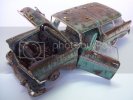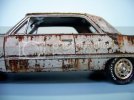pingvuiini
Member
- Joined
- Dec 8, 2012
- Messages
- 123
My latest simultaneous builds:
1/25 Revell 1968 Dodge Dart 426 Hemi, 1/35 Academy Tiger I Mid Production, 1/35 Tamiya JGSDF Type 90

This is the Academy kit with the full interior, which I skipped so I could have more fun weathering the exterior.


A nice, shiny Hemi 426 engine. But not for long!!!

1/35 Tamiya T-34/76 1942.


I just got this T-34 in the mail today and did a quick, sloppy build in less than 3 hours. After the Panther G fiasco and working with those individual track links its really nice to deal with single piece tracks. The Russian T-34s and KV tanks go together very quickly, with only 8 or 9 steps in the instructions. It's a testament to the simplicity of the genuine article.
1/25 Revell 1968 Dodge Dart 426 Hemi, 1/35 Academy Tiger I Mid Production, 1/35 Tamiya JGSDF Type 90

This is the Academy kit with the full interior, which I skipped so I could have more fun weathering the exterior.


A nice, shiny Hemi 426 engine. But not for long!!!

1/35 Tamiya T-34/76 1942.


I just got this T-34 in the mail today and did a quick, sloppy build in less than 3 hours. After the Panther G fiasco and working with those individual track links its really nice to deal with single piece tracks. The Russian T-34s and KV tanks go together very quickly, with only 8 or 9 steps in the instructions. It's a testament to the simplicity of the genuine article.



















































